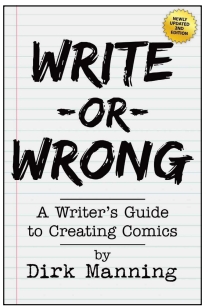About Writing…

(Illustration by Jan Apple, source: http://www.dirkmanning.com/)
This year marks my 20th anniversary as a published comic book writer (for those of you fellow old school online comic readers, yes, it’s been two decades since the debut of Nightmare World as one of the first fully- realized webcomics/online comic series), and as someone who’s been in the game for a long time now, let me tell you something you may hear other established creators remind you of as well:
As a writer – which oftentimes means you’re also a de facto project manager – it’s now more easy than ever to successfully create and publish your own comics.
With more social media platforms than I can count on one hand now available at your fingertips, it’s easier than ever to meet potential collaborators. Be it through online or print-on-demand, there are more affordable options than ever to get your comics in front of eyeballs everywhere. Finally, with the rise in acceptance of crowdfunding among mainstream comic readers – and the mainstream population in general – it’s easier than ever to fund the creation/printing of your comics.
For the sake of this column, let’s focus on that last one for a moment, shall we? After all, I was also at “Ground Zero” of creating the shape of modern comic book crowdfunding, too. One of the greatest misconceptions I see aspiring writers make in their desire to create comics is a mutation of the Field of Dreams mentality applied to crowdfunding: “I’ll just put it on Kickstarter.”
First off, there’s no “just” in running a Kickstarter (or, I can extrapolate, any other crowdfunding campaign). You will never, ever work harder than you will running a crowdfunding campaign, whether it’s funded in the first hour or the last hour. Running a crowdfunding campaign – when done with fidelity – is an almost all- encompassing endeavor in terms of participating in promotional efforts, writing updates, answering questions, etc. The mental taxation of running a campaign is real, and if you’re not inclined to believe me for whatever reason, ask anyone else who’s run a crowdfunding campaign. It’s a full-time job, and one that requires a lot of preplanning followed by an equal amount of execution and effort during – and even after – the campaign.
Logistics of running a campaign aside, there’s an even bigger elephant in the room that a lot of aspiring creators tend to overlook when their focus is trained on the process of producing the book ( and creating the crowdfunding campaign itself)… and if there’s only one thing you take from this column, I hope it’s this:
In order to crowdfund, you must have a crowd… and then know how to activate them.
How do you develop a crowd? How do you activate them? How can you best use the positive aspects and attributes of social media to find your tribe?
This could constitute a whole book (*cough*WriteorWrong*cough*) in and of itself, but for the sake of provoking thought – and honoring my word count for this column – I’ll sum it up in one word for now:
Intentionality.

Dirk Manning is the three-time Ringo Award nominated and #1 Amazon Best-Selling writer of graphic novels including Tales of Mr. Rhee, Nightmare World, Hope, The Adventures of Cthulhu Jr. and Friends, Twiztid Haunted High-Ons, Butts in Seats: The Tony Schiavone Story, Buried But Not Dead, and more. He’s also the author of Write or Wrong: A Writer’s Guide to Creating Comics and the Special Projects Manager at Source Point Press. He can be contacted on all social media platforms of note @DirkManning or through www.DirkManning.com.

